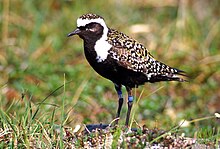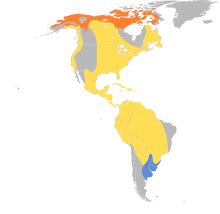American golden plover
| American Golden-Plover | |
|---|---|

| |
| Scientific classification | |
| Domain: | Eukaryota |
| Kingdom: | Animalia |
| Phylum: | Chordata |
| Class: | Aves |
| Order: | Charadriiformes |
| Family: | Charadriidae |
| Genus: | Pluvialis |
| Species: | P. dominica
|
| Binomial name | |
| Pluvialis dominica (Müller, PLS, 1776)
| |

| |
| Synonyms | |
|
Pluvialis dominica dominica | |
The American golden-plover (Pluvialis dominica), is a medium-sized plover. The genus name is Latin and means relating to rain, from pluvia, "rain". It was believed that golden plovers flocked when rain was imminent. The species name dominica refers to Santo Domingo, now Hispaniola, in the West Indies.[2]
Description

Measurements:[3]
- Length: 24–28 cm (9+1⁄2–11 in)
- Weight: 122–194 g (4+5⁄16–6+13⁄16 oz)
- Wingspan: 65–67 cm (25+1⁄2–26+1⁄2 in)
The breeding adult American Golden-plover has a black face, neck, breast, and belly, with a white crown and nape that extends to the side of the breast. The back is mottled black and white with pale, gold spots. The breeding female is similar, but with less black. When in winter plumage, both sexes have grey-brown upperparts, pale grey-brown underparts, and a whitish eyebrow. The head is small, along with the bill.[4]
It is similar to two other Golden-plovers, European and Pacific. The American Golden-plover is smaller, slimmer and relatively longer-legged than
Distribution
The breeding habitat of American golden plover is
A comparison of dates and migratory patterns leads to the conclusion that Eskimo curlews and American golden plovers were the most likely shore birds to have attracted the attention of Christopher Columbus to the nearby Americas in early October 1492, after 65 days at sea out of sight of land.[8]
Behavior
Breeding

This bird uses
The American golden plover lays a clutch of four white to buff eggs that are heavily blotched with both black and brown spots. The eggs generally measure around 48 by 33 mm (1+7⁄8 by 1+5⁄16 in). These eggs are incubated for a period of 26 to 27 days, with the male incubating during the day and the female during the night. The chicks then hatch precocial, leaving the nest within hours and feeding themselves within a day.[9]
Diet
These birds forage for food on tundra, fields, beaches and tidal flats, usually by sight. They eat terrestrial
Status
Large numbers were shot in the late 19th century and the population has never fully recovered.
References
- . Retrieved 15 February 2022.
- ISBN 978-1-4081-2501-4.
- ^ "American Golden-Plover Identification, All About Birds, Cornell Lab of Ornithology". www.allaboutbirds.org. Retrieved 2020-09-30.
- ^ ISBN 0-75258-734-X.
- .
- ^ Strewe, Ralf; Navarro, Cristobal (2004). "New and noteworthy records of birds from the Sierra Nevada de Santa Marta region, north-eastern Colombia". Bulletin of the British Ornithologists' Club. 124 (1): 38–51.
- ^ Herrera, Néstor; Rivera, Roberto; Ibarra Portillo, Ricardo; Rodríguez, Wilfredo (2006). "Nuevos registros para la avifauna de El Salvador" [New records for the avifauna of El Salvador] (PDF). Boletín de la Sociedad Antioqueña de Ornitología (in Spanish and English). 16 (2): 1–19.
- ^ Gollop, J.B.; Barry, T.W.; Iversen, E.H. (1986). "Eskimo Curlew - A vanishing species? : The Eskimo Curlew's Year - Introduction to Oceanic Migration". Nature Saskatchewan & United States Geological Survey. Archived from the original on 29 November 2009. Retrieved 22 December 2007.
- ^ ISBN 978-0-226-05781-1.
- ^ a b c "Pluvialis dominica (American golden plover)". Animal Diversity Web.
Further reading
- Hayman, Peter; Marchant, John; Prater, Tony (1986). Shorebirds: An identification guide to the waders of the world. Boston: Houghton Mifflin. ISBN 0-395-60237-8.
External links
- American golden plover at ENature.com
- BirdLife species factsheet for Pluvialis dominica
- "Pluvialis dominica". Avibase.
- "American golden plover media". Internet Bird Collection.
- American golden-plover photo gallery at VIREO (Drexel University)
- American Golden-Plover species account at Neotropical Birds (Cornell Lab of Ornithology)
- Interactive range map of Pluvialis dominica at IUCN Red List maps
- Audio recordings of American golden plover on Xeno-canto.
- Pluvialis dominica in Field Guide: Birds of the World on Flickr
- american-golden-plover/pluvialis-dominica American golden plover media from ARKive

